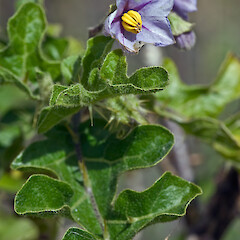Solanum linnaeanum
Common name
apple of Sodom
Family
Solanaceae
Flora category
Vascular – Exotic
Structural class
Trees & Shrubs - Dicotyledons
NVS code
The National Vegetation Survey (NVS) Databank is a physical archive and electronic databank containing records of over 94,000 vegetation survey plots - including data from over 19,000 permanent plots. NVS maintains a standard set of species code abbreviations that correspond to standard scientific plant names from the Ngä Tipu o Aotearoa - New Zealand Plants database.
SOLLIN
Conservation status
Not applicable
Habitat
Terrestrial.
Detailed description
Perennial shrub to 1m tall, generally stellate-hairy, branched, strongly armed; pricles yellow, to approx. 1cm long, glabrous or nearly so. Petioles to around 5cm long, prickly. Lamina to about 9 x 7cm, ovate to oblong, deeply pinnatisect, scarcely lobed in seedlings; lobes irregular, sinuate, with rounded apices, extending to 7/8 midrib, with hairs scattered above and mostly dense below, sometimes glabrate except for prickles on midrib and main veins; base truncate to rounded. Cymes few-flowered; pedicels to approx. 1cm long, densely stellate-hairy. Calyx 3~12mm long, often densely stellate-hairy, sometimes prickly, accrescent; lobes ovate to oblong, mainly = tube. Corolla 2.5~3.5cm diam., mauve or violet, stellate-hairy outside; lobes broadly ovate. Anthers 4~6mm long. Berry 1.5~3cm diam., almost globose, mottled green and white when immature, yellow at maturity; stone cells 0. Seeds approx. 3mm diam., subglobose to broad-obovoid. (-Webb et. al., 1988)
Similar taxa
Shrub or subshrub to 1-(3) m tall with many yellow thorns, berries green and white changing to yellow at maturity. Can be distinguished from other prickly Solanum spp. by the combination of perennial woody habit with clump forming roots, green leaves, mauve or violet flowers, September-May.
Flowering
September, October, November, December, January, February, March, April, May
Flower colours
Violet/Purple, Yellow
Fruiting
September to May
Life cycle
Perennial.
Year naturalised
1883
Origin
N Africa
Reason for introduction
Ornamental
Etymology
solanum: Derivation uncertain - possibly from the Latin word sol, meaning “sun,” referring to its status as a plant of the sun. Another possibility is that the root was solare, meaning “to soothe,” or solamen, meaning “a comfort,” which would refer to the soothing effects of the plant upon ingestion.
Poisonous plant
This species has been reported as poisonous if eaten.










